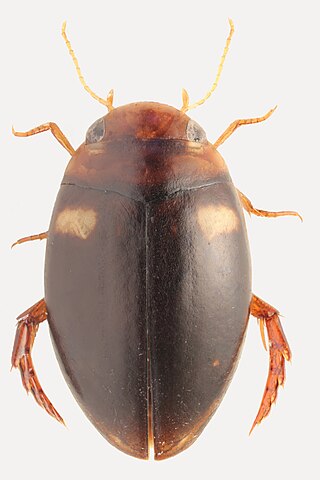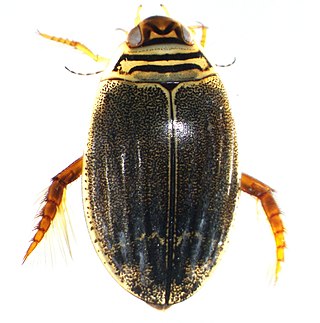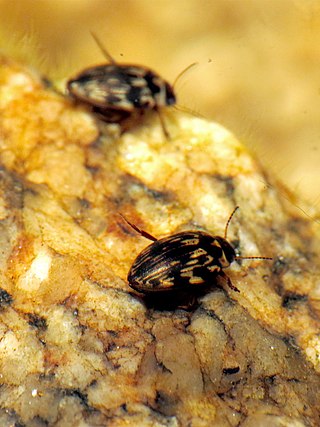
Amphizoa is a genus of aquatic beetles in the suborder Adephaga, placed in its own monogeneric family, Amphizoidae. There are five known species of Amphizoa, three in western North America and two in the eastern Palearctic. They are sometimes referred to by the common name troutstream beetles.

The Dytiscidae – based on the Greek dytikos (δυτικός), "able to dive" – are the predaceous diving beetles, a family of water beetles. They occur in virtually any freshwater habitat around the world, but a few species live among leaf litter. The adults of most are between 1 and 2.5 cm (0.4–1.0 in) long, though much variation is seen between species. The European Dytiscus latissimus and Brazilian Megadytes ducalis are the largest, reaching up to 4.5 cm (1.8 in) and 4.75 cm (1.9 in) respectively. In contrast, the smallest is likely the Australian Limbodessus atypicali of subterranean waters, which only is about 0.9 mm (0.035 in) long. Most are dark brown, blackish, or dark olive in color with golden highlights in some subfamilies. The larvae are commonly known as water tigers due to their voracious appetite. They have short, but sharp mandibles and immediately upon biting, they deliver digestive enzymes into prey to suck their liquefied remains. The family includes more than 4,000 described species in numerous genera.

Graphoderus is a genus of beetle in family Dytiscidae native to the Holarctic.

Rhantus is a genus of beetle in family Dytiscidae. There are about 100 species distributed worldwide. They often live in pools and marshy habitat types. Several species have colonized oceanic islands and become endemics.

Acilius is a holarctic genus of diving beetles in the family Dytiscidae and typically has a life cycle that is univoltine.

Agabus is a large genus of predatory aquatic beetles in the family Dytiscidae, proposed in 1817 by William Elford Leach and named after Agabus, an early follower of Christianity. The adult beetles are moderate-sized, 5 to 14 mm long. The genus is primarily Holarctic in distribution, with only a few species known from the Afrotropical and Neotropical realms. Three species of Agabus, namely A. clypealis, A. discicollis and A. hozgargantae are endangered according to the IUCN Red List. The division into subgenera is not widely accepted. However, a number of species groups are recognized after the works of David J. Larson and Anders N. Nilsson. The genus is probably polyphyletic or paraphyletic. In a recent study of mitochondrial DNA, Agabus was found paraphyletic with respect to several of the species groups of Platambus, a closely related genus in the tribe Agabini. Lately the taxonomy of the genus has been revised, and some groups of species were transferred from Agabussensu stricto to other genera in the tribe Agabini.

Thermonectus is a genus of beetle in family Dytiscidae. This genus is native to the New World, and mainly from warm temperate to tropical in distribution, but one species, T. basillaris occurs as far north as southern Ontario, Canada. They inhabit a wide range of freshwater habitats with static water and are often common. They are generally about 0.8–1.5 cm (0.3–0.6 in) long and a few species from desert pools in North America have a distinct yellow-spotted pattern on a black background.

Sandracottus is a genus of beetles in the family Dytiscidae. These aquatic beetles are found in ponds and slow streams from South Asia east to southern Japan, and south to Australia. They are generally about 1–1.5 cm (0.4–0.6 in) long and often have distinctive markings.

Hydrodytes is a genus of predaceous diving beetles in the family Dytiscidae. There are at least three described species in Hydrodytes. It is found in North America and the Neotropics.

Agabinae is a subfamily of predaceous diving beetles in the family Dytiscidae. There are about 11 genera and more than 460 described species in Agabinae.

Laccophilinae is a subfamily of ground and water beetles in the family Dytiscidae. There are at least 410 described species in Laccophilinae.

Colymbetini is a tribe of predaceous diving beetles in the family Dytiscidae. There are about 11 genera and more than 160 described species in Colymbetini.

Aciliini is a tribe of predaceous diving beetles in the family Dytiscidae. There are 7 genera and at least 69 described extant species in Aciliini, along with 5 fossil species.

Acilius semisulcatus is a species of predaceous diving beetle in the family Dytiscidae. It is found in North America.
Acilius abbreviatus is a species of predaceous diving beetle in the family Dytiscidae. It is found in North America.

Hydrodytinae is a subfamily of predaceous diving beetles in the family Dytiscidae. There are at least two genera and four described species in Hydrodytinae.
Madaglymbus is a genus of predaceous diving beetles in the family Dytiscidae. There are about 15 described species in Madaglymbus. They are found in Africa.

Boreonectes is a genus of predaceous diving beetles in the family Dytiscidae. There are about 16 described species in Boreonectes. They are found in North America, the Neotropics, and the Palearctic.

Neobidessodes is a genus of predaceous diving beetles in the family Dytiscidae. There are about 10 described species in Neobidessodes. They are found in Australasia. The genus was first described in 2009, and the type species is N. denticulatus.

Aspidytidae is a family of aquatic beetles of the suborder Adephaga, described in 2002 from specimens in South Africa and China. There are only two known species in the family and these were originally described in the genus Aspidytes, but later the new genus Sinaspidytes was erected for the species found in China. The family can also be referred to by its trivial name cliff water beetles.
















